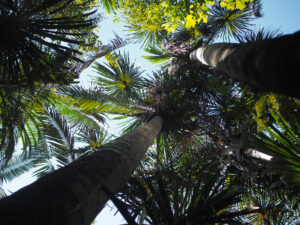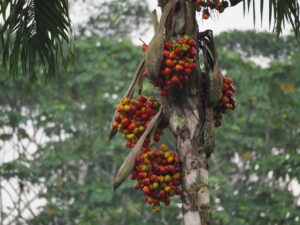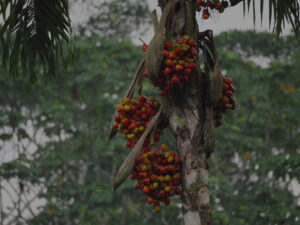02 JULY 2020
Did you know that the fruit pulp of the Amazon “Morete” palm, Mauritia flexuosa, contains more vitamin A than carrots, and more vitamin E than avocado? It´s also rich in protein, fat and carbs, and can be eaten fresh or made into juice, jam or pressed for oil.
Morete fruit oil is energising and emollient. Moisturising and rejuvenating for skin and hair, it even has the ability to filter UV rays, acting like a sun-block.
Common names: MORETE (Ecuador) MORICHE (Bolivia, Colombia, Puerto Rico, Venezuela), AGUAJE (Peru), BURITI (Brasil)
The Mighty Morete palm is a sight to behold. Just like the famous açaí, vast, wild “monocultures” of morete, can be found in swamps of the Amazon, since few other native tree species adapt to waterlogged soil.
These high-carbon swamps are wildlife hotspots – this superfruit is a staple food for a range of Amazonian birds and mammals.

Morete palms are incredibly “handy” for use in ecosystem restoration work – they help accumulate water in the soil, rehydrating degraded land.
One single Morete palm can produce over half a tonne of fruit per year. Fruiting begins 7-8 years after planting, when palms reach 6-7m in height. Morete can fruit at different times of the year, being dependent on dry spells to flower. The fruit is more complex to collect when palms reach their max. height of 35m.
Fibres from the Morete palm´s leaves can be used to make baskets, necklaces, and even hammocks. Each gigantic leaf petiole(the leaf stalk) can be up to 8 metres long, ending in a huge star-shaped leaf 3 metres in diameter.
Common names: MORETE (Ecuador) MORICHE (Bolivia, Colombia, Puerto Rico, Venezuela), AGUAJE (Peru), BURITI (Brasil)

Other articles of interest
02 JULY 2020
Did you know that the fruit pulp of the Amazon “Morete” palm, Mauritia flexuosa, contains more vitamin A than carrots, and more vitamin E than avocado? It´s also rich in protein, fat and carbs, and can be eaten fresh or made into juice, jam or pressed for oil.
Morete fruit oil is energising and emollient. Moisturising and rejuvenating for skin and hair, it even has the ability to filter UV rays, acting like a sun-block.
Common names: MORETE (Ecuador) MORICHE (Bolivia, Colombia, Puerto Rico, Venezuela), AGUAJE (Peru), BURITI (Brasil)
The Mighty Morete palm is a sight to behold. Just like the famous açaí, vast, wild “monocultures” of morete, can be found in swamps of the Amazon, since few other native tree species adapt to waterlogged soil.
These high-carbon swamps are wildlife hotspots – this superfruit is a staple food for a range of Amazonian birds and mammals.

Morete palms are incredibly “handy” for use in ecosystem restoration work – they help accumulate water in the soil, rehydrating degraded land.
One single Morete palm can produce over half a tonne of fruit per year. Fruiting begins 7-8 years after planting, when palms reach 6-7m in height. Morete can fruit at different times of the year, being dependent on dry spells to flower. The fruit is more complex to collect when palms reach their max. height of 35m.
Fibres from the Morete palm´s leaves can be used to make baskets, necklaces, and even hammocks. Each gigantic leaf petiole(the leaf stalk) can be up to 8 metres long, ending in a huge star-shaped leaf 3 metres in diameter.
Common names: MORETE (Ecuador) MORICHE (Bolivia, Colombia, Puerto Rico, Venezuela), AGUAJE (Peru), BURITI (Brasil)

Other articles of interest

THE MORETE PALM
An Amazonian Keystone Palm Species.

FOOD SECURITY
Seed Exchange for Food Security & Community Resilience.




